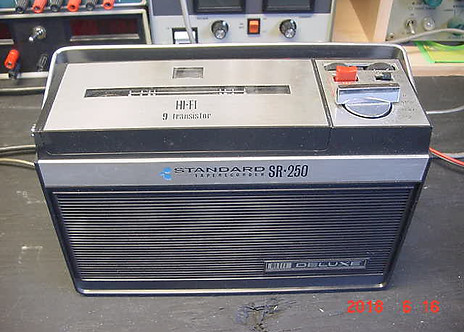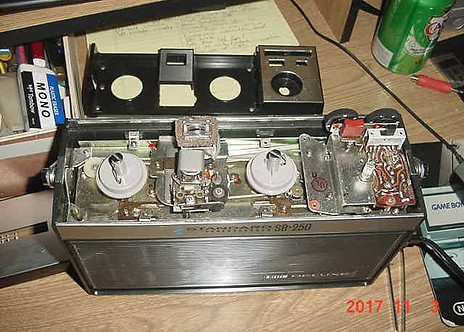
Sony TC-50
This is the Sony TC-50 cassette recorder. This unit came out in 1968, and was the smallest cassette machine produced at the time.
This model is famous as it was the model chosen by NASA to be taken aboard the command module of the Apollo moon missions.
There is a strong possibility this unit has actually been used by NASA, but not apparent in the pictures. The units used by the Apollo program (there was more than one) had a metal sticker on the front with operating instructions, as well as a special serial number stamped. The jacks were taped to make then unuseable. Velcro was affixed to the rear of the unit to facilitate the machine being stuck to the wall in the microgravity environment.
I have acquired two TC-50's. One was found at an estate sale back in 2007 or so. It was in very good cosmetic condition, but the motor had a problem that I made worse when trying to fix (it was my first attempt at a TC-50 repair). Later in 2013, I went to a now out-of-business place called "The Black Hole" in Los Alamos, New Mexico.
Ricky's Web Pages
"Once you label me, you negate me." --Søren Kierkegaard
Standard SR-250


This is a very nice little recorder! The Standard Radio Corp. model SR-250. Recorders by Standard are not seen quite as often as other more common brands, such as Sony and Panasonic, but there is something always very pleasing about Standard tape recorders. One nice thing about all of the Standard recorders I have come across is their use of a different kind (a more natural, if not mistaken) of rubber for use in their belts. Instead of the usual black rubber belts, the Standard recorders belts have white color, and never seem to stretch/go loose or even deteriorate with age. They just somehow stand the test of time remarkably well. I wish belts like this were used on all recorders using belts.
This is a very well-make little recorder. Little reels and big sound! It has a (1W, I believe) powerful amplifier and a four-inch loudspeaker. The sound quality is very full on this unit. Although best sound is achieved at 3 3/4 in/sec, this unit still can produce quite good recordings at 1 7/8 IPS, even though it does not change the equalization when changing the speed. Correction for 2025-01-12: It does change equalization, but only during record mode, to add more pre-emphasis of high frequencies at 1 7/8 IPS.
This unit is AC bias, and DC erase. Manual level control. Can run on five 'D' cells or 120VAC.
A Japanese classic from the 1960s. Still working on original parts except that it did need a new diode for the VU meter to work again in record mode.

